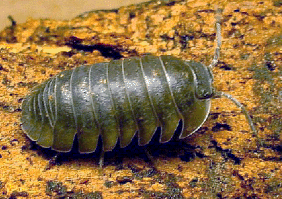
Consulting Entomologist

Tel/Fax: 01275 854224
E-Mail: [email protected]
Site Guide
Site Search
Home Page
Career Page
Insect Files
- Contents
- Bug Index
- The World of Bugs
- Classification of Bugs
- Insect Identification
- Insect Fossils
- Insect Body-parts
- Micro View of Bugs
- Insect Life Cycles
- Insect Defences
- Insects of Nailsea
- Pesticide Safety
- Bibliography
Shortcut to the main groups of insects and other arthropods...
Bug Rhymes & Poems
Links
Shop
Payments (credit/debit card)
Woodlice |
Class: Crustacea Order: Isopoda |
| This topic was prompted by several
enquiries about the control of woodlice found invading and infesting cellars, basements and other interior areas of buildings and homes . . . . . . | |
|
Woodlice are crustaceans related to slaters, shrimps, lobsters and crabs, and belong to a group of arthropods called the Isopoda (suborder Oniscoidea). They are the only crustaceans that have properly invaded land, without the need to return to water in order to breed, although they tend to be restricted to fairly damp places. There are several common woodlice similar to the species shown opposite. Most are flat oval creatures up to 15 mm (half an inch) long, with a grey or yellowish speckled back composed of 13 horny articulated plates. The head is quite small with a pair of angled, S-shaped antennae. There are seven pairs of short translucent legs, and a pair of very short caudal (or tail) appendages. |
|
|
Woodlice breathe through air-holes on the hindmost pair of legs and they feed chiefly on rotting wood and other decaying vegetable matter. The species illustrated above is abundant throughout Britain and Europe in woodland, hedgerows and gardens, especially under logs, leaf litter and in compost heaps. | |

 A pill woodlouse (Armadillidium) that can roll into a ball when disturbed |
There are some woodlice, called pill woodlice or pill-bugs, that are able to roll themselves into balls when disturbed - a habit that often leads to confusion with the rather similar looking pill millipede. The pill millipede (Glomeris), however, is much blacker and shinier, with many more legs (17-19 pairs) and a broad, almost semi-circular plate at the rear instead of the numerous small plates which form the tail-end of the woodlouse. Millipedes belong to a different class of arthropods, the Myriapoda. |
|
Woodlice are quite harmless and in fact beneficial in their proper habitat by promoting the breakdown of dead vegetation and organic matter in the soil. They normally live outdoors but shun the light by hiding under stones, logs, loose bark, leaf-litter etc., or in hollow tree-trunks - almost anywhere that is fairly damp. However, they frequently come indoors and may take up residence inside buildings, surviving in any dark, damp places they can find. When large numbers of woodlice are found indoors, perhaps clustered in wall crevices or under skirting boards etc., it is always worth checking for excessive dampness in these places - just in case there is a structural problem with the damp proofing or damp course. Woodlice (although not insects) are killed by most insecticides, and infestations inside houses and other buildings can be controlled by several of the insecticides sold for household or garden use. Probably the best products are the various insecticide powders available from hardware stores, garden centres and most supermarkets for controlling woodlice, ants and other crawling insects. If you intend using one of these insecticides, make sure you follow the instructions and advice on the product label. Avoid using insecticides in kitchens and other areas where food is stored or prepared. | |
|
Only treat the areas where woodlice are residing (the most usual places are under carpets, in cracks and crevices between floors and walls or behind skirtings). After about a week, go round the treated areas with a vacuum cleaner fitted with an edging-nozzle, to remove and flush-out dead animals. Badly infested areas may require several treatments. Avoid the build-up of large infestations inside buildings by regular inspection of places where woodlice might hide. Sprinkling an insecticide powder at the footings all round the outside of the building or house can help prevent or reduce re-invasion - this seems to deter woodlice, and also ants, earwigs and other crawling insects, from entering in the first place. REMEMBER TO USE INSECTICIDES SAFELY AND FOLLOW ALL THE INSTRUCTIONS ON THE PRODUCT LABEL | |
| - See the Pesticide Safety Page for General Precautions on Insecticide Use - | |
|
|
|
RELATED PAGES (Other Crustacea) |
|
MARINE & FRESHWATER CRUSTACEANS WATER FLEAS, BARNACLES, SLATERS, SHRIMPS, LOBSTERS, CRABS & THEIR RELATIVES |

(classification of crustaceans) |
| <<< TOP | (use the back button on your web browser to return to the previous page) | TOP >>> |